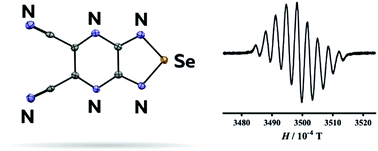Selenium & Tellurium chemistry at the beginning of the 3rd millennium: a celebration of ICCST
The paper of NIOCh's researchers is published in the journal New Journal of Chemistry, 2019, Vol. 43, N 41, Pp. 16331-16-337, (IF 3,069)
Design, synthesis and isolation of a new 1,2,5-selenadiazolidyl and structural and magnetic characterization of its alkali-metal salts
Nikolay A. Semenov, Ekaterina A. Radiush, Elena A. Chulanova, Alexandra M. Z. Slawin, J. Derek Woollins, Evgeny M. Kadilenko, Irina Yu. Bagryanskaya, Irina G. Irtegova, Artem S. Bogomyakov, Leonid A. Shundrin, Nina P. Gritsan and Andrey V. ZibarevNew Journal of Chemistry, 2019,43, 16331-16337
First published: 12 Sptember 2019
doi: 10.1039/C9NJ04069B

Abstract
5,6-Dicyano[1,2,5]selenadiazolo[3,4-b]pyrazine 1 was synthesized and electrochemically and chemically reduced into its radical anion [1]˙−, which was characterized by EPR spectroscopy and DFT calculations, and isolated in the form of homospin salts [K(18-crown-6)]+[1]˙− (2) and [Na(18-crown-6)]+[1]˙− (3). The crystal structure of 2 revealed π-dimers of [1]˙− featuring a shortened interplanar separation of 3.18 Å, and that of 3 showed chains of alternating cations and anions. DFT and CASSCF calculations on the π-dimers of [1]˙− suggest a closed-shell singlet ground state with a noticeable contribution of diradical character. According to EPR and SQUID magnetometry, salt 2 is diamagnetic in the range of 2–300 K, whereas salt 3 is paramagnetic and reveals weak antiferromagnetic exchange interactions.
Altmetrics:


